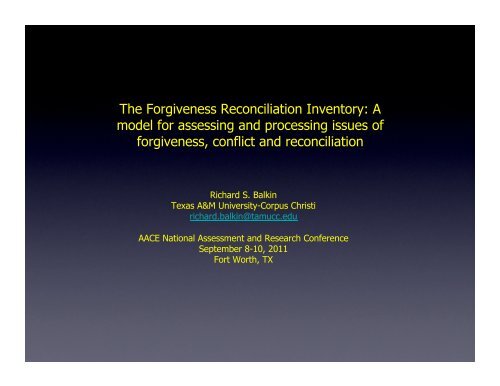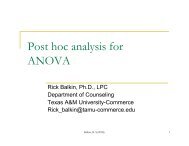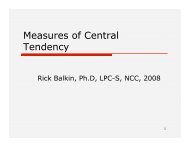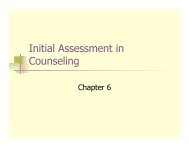The Forgiveness Reconciliation Inventory: A model for assessing ...
The Forgiveness Reconciliation Inventory: A model for assessing ...
The Forgiveness Reconciliation Inventory: A model for assessing ...
- No tags were found...
You also want an ePaper? Increase the reach of your titles
YUMPU automatically turns print PDFs into web optimized ePapers that Google loves.
<strong>The</strong> <strong>Forgiveness</strong> <strong>Reconciliation</strong> <strong>Inventory</strong>: A<strong>model</strong> <strong>for</strong> <strong>assessing</strong> and processing issues of<strong>for</strong>giveness, conflict and reconciliationRichard S. BalkinTexas A&M University-Corpus Christirichard.balkin@tamucc.eduAACE National Assessment and Research ConferenceSeptember 8-10, 2011Fort Worth, TX
<strong>Forgiveness</strong> <strong>The</strong>ory• Interpersonal <strong>for</strong>giveness (Enright andthe Human Development Study Group,1991; Murray, 2002; Scobie & Scobie,1998; Walton, 2005)• Intrapersonal <strong>for</strong>giveness (Hall &Fincham, 2005; Scobie & Scobie, 1998;Walton, 2005)• <strong>Forgiveness</strong> and reconciliation (Berecz,2001; Enright and the HumanDevelopment Study Group, 1994;Macaskill, 2005; Powers, 1994)Balkin, R. S., 20112
Religious Conceptualization of<strong>Forgiveness</strong>• Secular (Enright, Freedman and Rique ,1998; Tagney, Fee, Reinsmith, Boone, &Lee, 1999)• Christian (Walker & Gorsuch, 2004)• Jewish (Cohen, Malka, Rosen, & Cherfas,2006)• Hindu (Akanksha and Etienne, 2010)Balkin, R. S., 20113
Decision ModelBeneficialRemorse/changeNo remorse/changeNon-beneficialBalkin, R. S., 20114
Assessing a Client’s Likelihoodto Forgive• <strong>Forgiveness</strong> Scale (Rye, 1998)• <strong>Forgiveness</strong> Likelihood Scale (Rye, 1998)• <strong>Forgiveness</strong> <strong>Reconciliation</strong> <strong>Inventory</strong> (Balkin)Balkin, R. S., 20115
<strong>Forgiveness</strong> Scale• Designed to measure <strong>for</strong>giveness toward a particularoffender• developed as part of an earlier study involving collegewomen who had been wronged in a romanticrelationship• 15 items using a Likert-type <strong>for</strong>mat with responsepossibilities ranging from 1 (Strongly disagree) to 5(Strongly agree).Balkin, R. S., 20116
<strong>Forgiveness</strong> Scale• Respondents are instructed to think about how theyhave responded to the person who wronged ormistreated them. • Sample items include “I spend time thinking aboutways to get back at the person who wronged me”and “If I encountered the person who wronged me Iwould feel at peace.” • Higher scores on this scale reflect greater <strong>for</strong>givenesstoward an offender.• Two subscales: Absence of Negative (.86) andPresence of Positive (.85)Balkin, R. S., 20117
Balkin, R. S., 20118
<strong>Forgiveness</strong> Likelihood Scale• developed as part of an earlier study involving collegewomen who had been wronged in a romanticrelationship (Rye, 1998). Balkin, R. S., 20119
<strong>Forgiveness</strong> Likelihood Scale• Ten scenarios were developed involving hypotheticalwrongdoing.• Scenarios were designed to assess a variety of typesof wrongdoing (e.g., infidelity, slander, theft) to whichcollege students would likely be able to relate andprovide a meaningful judgment. Balkin, R. S., 201110
<strong>Forgiveness</strong> Likelihood Scale• Respondents are instructed to imagine that thescenarios happened to them and then consider thelikelihood that they would be willing to <strong>for</strong>give theoffender. • <strong>The</strong> scale uses a Likert-type <strong>for</strong>mat with responsepossibilities ranging from 1 (Not at all likely) to 5(Extremely likely). Balkin, R. S., 201111
<strong>Forgiveness</strong> Likelihood Scale• Sample items include “One of your friends starts anasty rumor about you that is not true. As a result,people begin treating you worse than they have in thepast. What is the likelihood that you would choose to<strong>for</strong>give your friend?” and “Your significant other has a‘one night stand’ and becomes sexually involved withsomeone else. What is the likelihood that you wouldchoose to <strong>for</strong>give your significant other?” Balkin, R. S., 201112
<strong>Forgiveness</strong> Likelihood Scale• Higher scores on this scale reflect increasedwillingness to <strong>for</strong>give.• <strong>The</strong> instrument produces one scale score with strongreliability estimates (.81).Balkin, R. S., 201113
Balkin, R. S., 201114
Balkin, R. S., 201115
<strong>Forgiveness</strong> <strong>Reconciliation</strong>• Researcher developed<strong>Inventory</strong> (FRI)• Based on a theoretical <strong>model</strong> of interpersonal andintrapersonal <strong>for</strong>giveness• Strong psychometric propertiesBalkin, R. S., 201116
Decision ModelBeneficialRemorse/changeNo remorse/changeNon-beneficialBalkin, R. S., 201117
Balkin, R. S., 201118
Participants• Two hundred participants were solicitedfrom nonclinical settings (N = 131, 65.5%)including undergraduate and graduatestudents on a university campus in the Southand consenting professionals from acommunity-based education program, andfrom clinical settings (N = 69, 34.5%)including a correctional setting, outpatientwomen’s recovery center, and domesticabuse shelter in the Northeast, and adomestic abuse shelter in the South.Balkin, R. S., 201119
Participants• Participants were 35 (17.5%) males and165 (82.5%) with the following ethnicbreakdown:• white (N = 115, 57.5%)• Latino/a (N = 47, 23.5%),• African American (N = 18, 9.5%)• Asian (N = 8, 4%)• other (N = 8, 4%)• missing (N = 4, 2%)Balkin, R. S., 201120
Analyses• EFA• Reliability estimation• Evidence of relationships to other variables:• canonical correlation to the FS• multiple regression to the FLS• Exploration of group differences betweenclinical and nonclinical participants• MANOVA and discriminant analysisBalkin, R. S., 201121
Factor Structure• Conducted EFA (N = 200)• fixed four-factor extraction• using MLE a promax rotation due tocorrelated factors (Dimitrov, 2010)• Eigen values and scree plots indicated a fourfactorsolution, consistent with thetheoretical underpinnings of the <strong>model</strong>• Accounted <strong>for</strong> 66% of the variance in the<strong>model</strong>Balkin, R. S., 201122
Balkin, R. S., 201123
Psychometric Qualities ofthe FRI• Strong reliability (internal consistency)estimates (N = 200)• Exploration: .89 (.90, remove item 7)• Role: .85 (.88, remove item 9)• Change: .90 (.92, remove item 21)• Outcome: .93 (.93, remove item 23)Balkin, R. S., 201124
Psychometric Qualities ofthe FRI• Evidence of a strong relationship to the<strong>Forgiveness</strong> Scale (Rye, 1998).• Conducted a canonical correlation• A significant relationship and strongeffect size accounting <strong>for</strong> 49% of thevariance [ = .49, F(8, 326) = 17.62, p< .001].• Increased positive attributes on the FRIcorrelated with higher degrees of<strong>for</strong>giveness toward an offender.Balkin, R. S., 201125
Psychometric Qualities ofthe FRI• Evidence of a strong relationship to the<strong>Forgiveness</strong> Likelihood Scale (Rye, 1998).• Conducted a multiple regression.• A significant relationship and strongeffect size accounting <strong>for</strong> approximately10% of the variance, F(4, 165) = 4.54, p= .002.• Increased positive attributes on the FRIcorrelated with higher likelihood to<strong>for</strong>give.Balkin, R. S., 201126
DescriptivesScale N M SD Role Change Outcome FSneg FSpos FLSExplorationrolechangeOutcomeFSnegFSposFLS20020020020017317317320.1017.5522.0820.4733.5615.1624.286.066.216.436.957.914.838.92.46*.47*.57*.42*.67*.68*-.40*-.42*-.32*-.44*-.41*-.52*-.50*-.67*.51*-.22-.20-.09-.23.25*.32**p < .001Balkin, R. S., 201127
Group Differences• Conducted a MANOVA with a discriminant analysis post hoc across FRIsubscales between clinical and nonclinical populations• λ = .885, F(4, 195) = 6.22, p < .001Scale Correlation Coefficients Standardized CoefficientsExploration .19 -.39Role .88 .98Change .68 .58Outcome .50 -.36• Functions at group centroids:• Clinical: .49• Nonclinical -.26Balkin, R. S., 201128
Group DifferencesGroup N M SD dclinical 69 20.57 6.34 0.12Nonclinical 13119.85 5.92clinical 69 20.15 6.52 0.65Nonclinical 131 16.18 5.60clinical 69 24.26 6.09 0.54Nonclinical 13120.93 6.33clinical 69 22.25 7.45 0.39Nonclinical 13119.52 6.51Balkin, R. S., 201129
FRI ProfileBalkin, R. S., 201130
Sample Profile 1Balkin, R. S., 201131
Sample Profile 2Balkin, R. S., 201132
Sample Profile 3Balkin, R. S., 201133
Sample Profile 4Balkin, R. S., 201134
QuestionsBalkin, R. S., 201135











